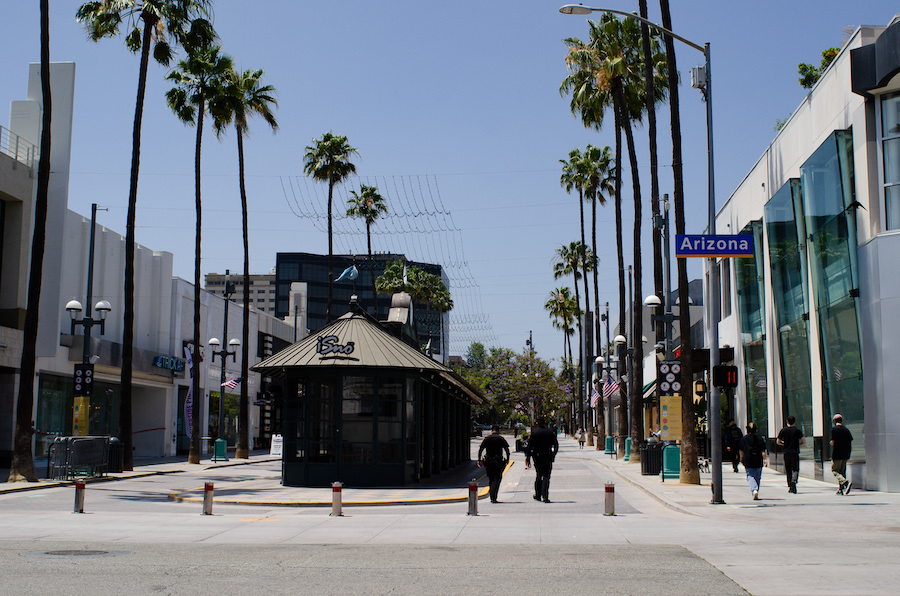
PART I
This week the City Council started discussing the next move for the Santa Monica Promenade, our beleaguered and onetime downtown city jewel. Beset by collapsing sales, contagious vacancies, safety and sanitation issues, the onetime city jewel has lost its luster. In its current status report, the city notes that nearly 40% of The Promenade’s storefronts are vacant, with over 60% of these vacancies (24% of total vacancies) predating the onset of Covid-19. The picture is arguably no better at the southern anchor of Santa Monica Place (SM Place). The departure of Bloomingdales will expand the current 11% floorspace vacancy rate to over 30%.
But this is a movie we have seen before. We are in the second decline cycle for The Promenade (originally known as the Santa Monica Mall). Primarily due to the City’s reactionary downtown business strategy, the business cycles of SM Place and The Promenade have been fortuitously counter-cyclical since 1965. Now, for the first time, downtown Santa Monica is experiencing simultaneous declines at both the Promenade and SM Place. However, this problem creates new opportunities.
Pre-Promenade
Prior to closing off 3rd Street in 1965 to automobile traffic, the area’s shops were an integral part of the resident com-munity’s daily routine. The former Barnes and Noble on 3rd and Wilshire was a Ralphs grocery market while the former GAP building was the first home of Busy Bee Hardware.
Promenade 1.0
Launched in 1965, the first Promenade decline started in the 1970s. The opening of Santa Monica Place in 1980 was a key initiative to revitalize the downtown shopping area. However, the SM Place plan did not integrate the Promenade, accelerating its decline.
A rebound plan was launched in 1984 with a strategy to create a new entertainment-centric destination to harness the interest of a broad range of clientele built around broad cuisine choice and the magnet of anchor movie theaters sur-rounded by design esthetics of dinosaur topiaries, kiosks, new lights etc. The strategy set it apart from Santa Monica Place and made it a complimentary destination.
Promenade 2.0
Reopening in 1989 as the renamed the Santa Monica Promenade, it became a vibrant and successful outdoor pedestrian mall and planners flocked to see what the secret sauce was that Santa Monica had deployed. The Bayside District Corporation (later DTSM) choreographed regular business-enhancing events and it had free or inexpensive parking structures nearby. Combined with the ambiance of its charming intact historical intact façades (W.T Grant, J.C. Penney), it felt like an authentic main street. Note: Historical buildings sell authenticity and can create value which must remain an integral part of any new design.
While there may not have been any single reason for its success in the early years of the newly revamped corridor, its opening coincided with a constellation of positive developments (for Santa Monica). Local outdoor competition in the form of Westwood Village unexpectedly collapsed in the early 90s. Loews Santa Monica Beach Hotel, which started the ritzy wave on the shore, opened in 1989. Shutters opened in 1993 followed later by Casa del Mar and Le Merigot Santa Monica Beach Hotel, both debuting around 2000. City-wide tourist visitors numbered 3M in 2000 and grew by 6% annually. By 2018 the city-wide tourist visits had increased 180% to 8.4M annually. City-wide tourist spend in 2016 was $1.87 billion with the Promenade accounting for approximately 10% of the total.
But trouble was brewing. The success of the Promenade coincided with the onset of slow decline of Santa Monica Place. In 2010, SM Place was relaunched as an open-air mall featuring an open-air courtyard, upscale shops and a top floor food court. The relaunch also formally included the mall as an “integrated component” of the Promenade. Traffic strains persisted, and the Arc Light theater was retrofitted to SM Place, opening on November 15, 2015. The Promenade now had direct competition for a movie destination attraction within a couple city blocks.
This business ecosystem reached its apogee around 2015. A 2018 study by DTSM found that business spend (not traffic) was driven by a triad of distinct customer segments: Regional visitors from across Greater Los Angeles (45%), Tourists (41% of spend), with Residents (14%) bringing up the rear.
But lasting success was elusive. Sales at the Promenade declined 10% between 2015 and 2018, from $484 million to $435 million. The Promenade had become so successful that rents soared, eventually choking out the original small local and family run businesses that had provided so much charm and diversity. Meanwhile, accelerating trends in online shopping, streaming video services and food-delivery apps challenged traditional business models in each area. Eventually even big businesses such as Borders (2009), Barnes and Noble (2017), Banana Republic (2019) and Gap (2019) succumbed.
Parallel Declines
Unlike prior business cycle declines, both SM Place and the Promenade are in parallel declines, primarily driven by their convergent business models and consumer segments. Not only are the business models of destination anchor tenants (movies and large box retail) in both locations simultaneously under severe strain by fundamental consumer trend changes, one of the two most profitable consumer traffic flows, tourists, has all but evaporated.
Adding to the challenges of a collapse in business fundamentals is the significantly increased adjacent high-quality competition over the past 20 years. In 1990, there were four main competitors to the Promenade, none of which were in Santa Monica. By 2020, the Promenade had 24 competitors within a 20-minute drive, five (21%) of which were within Santa Monica. The most relevant competitors are in Santa Monica, or are Santa Monica adjacent: Main Street, Montana Avenue and Abbott Kinney. Two emerging competing Santa Monica locales that have the potential to augment the Promenade experience in a well-designed revitalization plan: 2nd Street and 4th Street.
Particularly relevant to the Promenade’s revitalization are the business elements present in the successful adjacent competitors: local resident support, unique dining, local boutiques, and historic preservation. Unlike Abbot Kinney, the Promenade boasts access to ample affordable off-site parking that also serves 2nd and 4th Streets.
Changing Consumer Behavior – Decline of the Traditional Destination
The key revitalization challenge facing the City is understanding the impact of fundamental technology and economic-driven changes in the behavior of the Promenade’s target resident, tourist and regional visitor consumers.
Theatrical movies as a destination will continue to decline. New releases day-and-date with in-home streaming services will likely further drive the movie theater experience upscale. Amenities will compensate for the diminishing theatrical exclusivity of a new title release. More new releases will be consumed at home. Still, most of these tectonic shifts are still only vaguely understood. Unlike prior cycles, there are no obvious new urban destination models emerging.
Managing the Ever-Changing Consumer Mix
In this environment, a substantial commitment of capital to a a vaguely understood new destination model, especially by a diverse storefront ownership and lessee base, carries heightened risks. The Tourist-driven model has relied on increasingly large volumes of essentially one-time consumers of leisure and luxury products spreading spending across their stay. Regional visitors have been usually concentrated to the weekends. Both groups have produced large concentrated spikes in the City’s population that has strained safety services and increase traffic and congestion. In essence, the city’s residents have subsidized these business models with the non-monetary tax of a decline in quality of life.
In contrast, resident spending on the Promenade (at 14% of the total) has only been about 30% of either tourists (41% of the total) or regional visitors (45% of the total). It’s clear that the Promenade’s product offerings and overall experience have not provided a compelling daily utility value to residents. Moreover, the product offerings and pricing related to these externally generated tourist and visitor traffic segments has disconnected the residents’ sense of belonging to the Promenade specifically and downtown generally, which is part of the non-monetary tax on residents. Meanwhile, retailers of high-utility resident-centric products such as bookstores, hardware and grocery stores have abandoned either the city center, the city overall, or both, taking the resident shopping spend with them.
Next week, we will explore alternatives and opportunities for the Promenade’s new future.
By Marc L. Verville and Michael Jolly for SMa.r.t. (Santa Monica Architects for a Responsible Tomorrow)
Thane Roberts, Architect, Robert H. Taylor AIA, Ron Goldman FAIA, Architect, Dan Jansenson, Architect, Building and Fire-Life Safety Commission, Samuel Tolkin Architect, Mario Fonda-Bonardi, AIA, Planning Commissioner, Marc L. Verville CPA (inactive), Michael Jolly, AIRCRE













